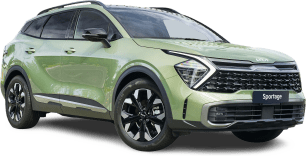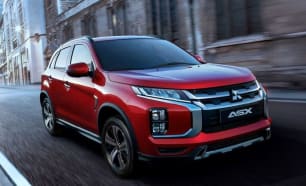Kia has been kicking serious goals lately when it comes to interior design, comfort and materials. The Sorento is a stellar example of thoughtful and appealing design. Thankfully, the Sportage follows suit.
As is often the case, particularly with Kia and sister brand Hyundai, the higher grades make the entry-level models look like stripped out, bargain basement offerings.
While the Sportage GT-Line has high-end fittings and a massive connected screen, the base Sportage S has none of the fancy tech, a budget screen and it’s missing armrests and more.
However, we are assessing the GT-Line so best to compare with similar rivals.
There’s a lot to like in the cabin, from the soft-touch materials on the dash, to the gloss black and lovely grey woodgrain inserts. There’s no mistaking this for anything but the top-spec model.
Thank goodness for the digital air con controls that sit between the screen and console. You don’t have to fumble through a menu on a screen like some models.
The nicely laid out centre console houses a drive mode selector, seat heating and cooling controls, gear dial (don’t love) two sizeable cup holders you can convert into one big space, and a gear shifter dial instead of the lever found in lower grades.
Kia’s well-designed three-spoke leather-appointed steering wheel houses clear controls and it feels nice to touch.
Cool retro-looking air vents sit on either side of the main screen, which is curved. Actually, it’s two 12.3-inch screens side by side, seamlessly integrated. It’s an interesting approach from Kia, and it works.
The instruments are clear and configurable to show different vehicle information, but it lacks a head-up display. Kia might think it doesn’t require one, but it wouldn’t go astray.
Kia’s multimedia system is a winner. It’s intuitive, simple to navigate and the graphics and icons are modern and visually appealing. Every single one of Kia’s Japanese rivals, except maybe Mazda, take note.
Connecting the phone to Bluetooth is quick and easy and there were no connection issues with the wired Apple CarPlay. Hopefully Kia and Hyundai add wireless CarPlay to higher grade models soon. Many entry grades have the wireless set-up.
Storage-wise a phone fits neatly in to the wireless charging slot that has a sliding cover, and the central bin has enough room but it’s not huge. Same goes for the glove box.
Door bottle storage is tight up front and we couldn’t get thicker bottles in there.
The perforated leather-appointed front seats with synthetic suede look lovely and offer great upper body support, but could to with more under-thigh bolstering. Regardless, they are very comfortable.
Kia has stretched the new Sportage by 175mm in length compared to the old one, which has added 80mm to the wheelbase, and it shows. The second row is so much more spacious than the model it replaced. There’s plenty of toe, knee and legroom and the panoramic sunroof has no impact on headroom back there, even for my six-foot (183cm) frame.
Conveniences back there include lower air vents, two USB-C ports on the rear of the front seats, map pockets on both sides, a storage nook under the vents, a coat hanger hook on the seat backs and a very handy slot for a phone or tablet in the back of the front headrests. Oddly, bottles slot in to the doors more easily in the rear.
Rear seats have some upper body bucketing and are quite comfortable. The centre armrest folds down with two cupholders and the backrests recline. The 60/40 seats can be lowered easily via levers in the boot and they fold close to flat.
It has a full-sized spare wheel under the boot floor and shopping back hooks. With the rear seats up it can swallow 543 litres – more than the old one – and 1829L with the second row stowed. That’s more than the new Mitsubishi Outlander and slightly more than the Toyota RAV4.






.png)










































.png)





















 copy.png)














